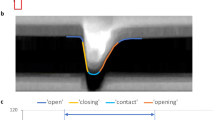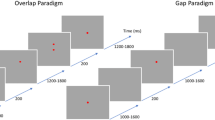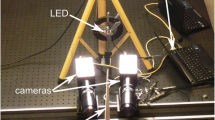Abstract
Purpose
To further evaluate the spontaneous eyeblink rate (SEBR) of healthy adult human subjects according to direction of gaze, especially in the presence of bright light reflective glare.
Methods
On 32 subjects aged between 18 and 24 years, separate video recordings of 5 min duration were made with different conditions of gaze (horizontal, slightly upwards or slightly downwards) under normal lighting or a distant lighting glare source.
Results
The SEBR in primary eye gaze under normal lighting was 11.7 +/− 0.9 eyeblinks/min with a coefficient of variation (COV) of 20.5 %. A non-significant decrease in SEBR was noted with downward gaze, but a slight significant increase with upward gaze in both SEBR (to 13.0 +/− 1.1 eyeblinks/min) and COV (average 26.1 %). In the presence of glare, SEBR in primary eye gaze increased significantly (p < 0.001) to 14.4 +/− 1.3 eyeblinks/min, with an obvious time-related progressive increase (p < 0.001). On upward gaze in the presence of a glare stimulus, SEBR progressively increased even further (average 15.0 +/− 2.4 eyeblinks/min; p < 0.001), as did the COV (to 29.2 %).
Conclusions
The results indicate that spontaneous eyeblink activity in silence can be affected by the presence of a glare light source, especially if the subjects are looking slightly upwards. This scenario should be avoided, if at all possible, in assessments of spontaneous eyeblink activity.





Similar content being viewed by others
References
Ponder E, Kennedy WP (1927) On the act of blinking. Quart J Exp Physiol 18:89–110
Stern JA, Walrath LC, Goldstein R (1984) The endogenous eyeblink. Psychophysiol 21:22–33
Doughty MJ (2001) In consideration of three types of spontaneous eyeblink activity in normal humans – during reading and VDT use, in primary gaze and while in conversation. Optom Vis Sci 78:712–725
Cruz AAV, Garcia DM, Pinto CT, Cechetti SP (2011) Spontaneous eyeblink activity. Ocular Surface 9:29–41
Wolkoff P, Nojgaard JKm Troiano P, Piccoli B (2004) Eye complaints in the office environment: precorneal tear film integrity influenced by eye blinking efficiency. Occupat Environm Med 62:4–12
Palakuru JR, Wang J, Aquavella JV (2007) Effect of blinking on tear dynamics. Invest Ophthalmol Vis Sci 48:3032–3037
Mori A, Egami F, Nakamori K, Ohtsuki T, Aikawa K, Shintani M, Matsumoto Y, Goto E, Tsubota K (2008) Quantitative videographic analysis of blink patterns of newscaters. Graefes Arch Clin Exp Ophthalmol 246:1449–1453
Himebaugh NL, Begley CG, Bardley A et al (2009) Blinking and tear break-up during four visual tasks. Optom Vis Sci 86:E106–E114
Cardona G, Garcia C, Serés C, Vilaseca M, Gispets J (2011) Blink rate, blink amplitude, and tear film integrity during dynamic visual display terminal tasks. Curr Eye Res 36:190–197
Ousler GW, Hagberg KW, Schindelar M, Welch D, Abelson MB (2008) The ocular protection index. Cornea 27:509–513
Doughty MJ, Naase T, Button NF (2009) Frequent spontaneous eyeblink activity associated with reduce conjunctival surface (trigeminal nerve) tactile sensitivity. Graefes Arch Clin Exp Ophthalmol 247:939–946
Ernstgärd L, Iregren A, Sjögren B, Johanson G (2006) Acute effects of exposure to vapours of acetic acid in humans. Toxicol Lett 165:22–30
Ernstgärd L, Iregren A, Juran S, Sjögren B, Van Thriel C, Johanson G (2008) Acute effects of exposure to vaopours of standard and dearomatized white spirits in humans. 2. Irritation and inflammation. J Appl Toxicol 29:263–274
Skotte JH, Nøjgaard JK, Jørgensen LV, Christensen KB, Sjøgaard G (2007) Eye blink frequency during different computer tasks quantified by electrooculography. Eur J Appl Physiol 99:113–119
Barbato G, De Padova V, Paolillo AR, Arpaia L, Russo E, Ficca G (2007) Increased spontaneous eye blink rate following prolonged wakefulness. Physiol Behav 90:151–154
Helland M, Horgen G, Kvikstad TM, Garthus T, Bruenech JR, Aarås A (2008) Musculoskeletal, visual and psychosocial stress in VDU operators after moving to an ergonomically designed office landscape. Appl Ergonomics 39:284–295
Nielsen PK, Sogaard K, Skotte J, Wolkoff P (2008) Ocular surface area and human eye blink frequency during VDU work: the effect of monitor position and task. Eur J Appl Physiol 103:1–7
Lang I, Bruckner T, Triebig G (2008) Formaldehyde and chemosensory irritation in humans: a controlled human exposure study. Regulatory Toxicol Pharmacol 50:23–36
Ziegler AE, Zimmer H, Triebig G (2008) Exposure study on chemosensory effects of e-caprolactam in the low concentration range. Int Arch Occup Envirn Health 81:743–753
Mueller JU, Bruckner T, Triebig G (2013) Exposure study to examine chemosensory effects of formaldehyde on hyposensitive and hypersensitive males. Int Arch Occup Environ Health 86:107–117
Doughty MJ (2013) Effects of background lighting and retinal illuminance on spontaneous eyeblink activity of human subjects in primary eye gaze. Eye Contact Lens 39:138–146
Nahar NK, Sheedy JE, Hayes J, Tai YC (2007) Objective measurements of lower-level visual stress. Optom Vis Sci 84:620–629
Gowrisankaran S, Sheedy JE, Hayes JR (2007) Eyelid squint response to asthenopia-inducing conditions. Optom Vis Sci 84:611–619
Aakre BM, Doughty MJ (2007) Are there differences between ‘visual symptoms’ and specific ocular symptoms associated with video display terminal (VDT) use ? Contact Lens Anterior Eye 30:174–182
Doughty MJ, Blades KA, Ibrahim N (2002) Assessment of the number of eye symptoms, and the impact of some confounding variables, for office staff in non-air-conditioned buildings. Ophthal Physiol Opt 22:143–155
Doughty MJ, Naase T (2006) Further analysis of the human spontaneous eyeblink rate by a cluster-analysis-based approach, to categorise individuals with ‘normal’ versus ‘frequent’ eyeblink activity. Eye Contact Lens 32:294–299
Doughty MJ (2002) Further assessment of gender and blink pattern-related differences in the spontaneous eyeblink activity in primary gaze in young adult humans. Optom Vis Sci 79:439–447
Luckiesh M, Guth SK, Eastman AA (1947) The blink rate and ease of seeing. Illuminating Engn 1(42):584–588
Tinker MA (1949) Involuntary blink rate and illumination intensity in visual work. J Exp Psychol 29:558–560
Simonson E, Brozek J (1948) Effects of illumination on visual performance and fatigue. J Opt Soc America 38:384–397
Wood CL (1950) Bitterman C (1950) blinking as a measure of effort in visual work. Am J Psychol 63:584–588
Kleitman N, Schreider JE (1951) Diurnal variation in oculomotor performance. Annee Psychol 50:202–215
Zaman ML, Doughty MJ, Button NF (1998) The exposed ocular surface and its relationship to spontaneous eyeblink rate in elderly Caucasians. Exp Eye Res 67:681–686
Zaman ML, Doughty MJ (1997) Some methodological issues in the assessment of the spontaneous eyeblink frequency in man. Ophthal Physiol Opt 17:321–432
Acknowledgments
The author would like to thank Drs. Taher Naase, Emil Oblak, and Mohamed Laquizzaman for assistance with some of the initial recordings for this study. The author has no proprietary interests in any of the protocols or instrumentation used in the present study.
Author information
Authors and Affiliations
Corresponding author
Rights and permissions
About this article
Cite this article
Doughty, M.J. Spontaneous eyeblink activity under different conditions of gaze (eye position) and visual glare. Graefes Arch Clin Exp Ophthalmol 252, 1147–1153 (2014). https://doi.org/10.1007/s00417-014-2673-8
Received:
Revised:
Accepted:
Published:
Issue Date:
DOI: https://doi.org/10.1007/s00417-014-2673-8




